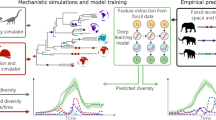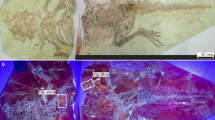Abstract
THERE has been disagreement on morphological and palæontological grounds as to the relationship of the groups of true Neuroptera and Megaloptera. In the first place, take the family Sisyridse of the true Neuroptera (or Planipennia). Its members possess aquatic larvæ, and as they have some morphological features in common with Osmylidæ, the larvæ of which are semi-aquatic, Tillyard1 in 1916 put forward the suggestion that it had to be regarded as a comparatively late offshoot of the latter. This view was then adopted by Withycombe2, and recently Killington3 in his admirable monograph of the British Neuroptera maintains the idea that ” these two families are no doubt closely allied, and, indeed, it appears very probable that the Sisyridae have been derived from an Osmyloid ancestor”. On the other hand, Handlirsch4 was not of the opinion that the families were very nearly related, and pointed out that Sisyridae show a remarkable similarity with the then oldest known fossil remnants of true Neuroptera, that is, the Triassic Prohemerobidae, the larvae of which are supposed to have been aquatic also. Recently, Handlirsch5 (and Beier), after having considered the discoveries of true Neuroptera in the Permian by Tillyard6 and Martynov7, also directs attention to the striking resemblance of some of these very old remnants with the living Sisyridae, which group he stil] regards as a primitive and primarily aquatic one. Tillyard8 seems later to have given up his original view and regarded Sisyridae as ” a specialized side branch” not very close to Osmylidae. After much dispute, therefore, morphologists have come to no agreement on the relationships of the two groups.
This is a preview of subscription content, access via your institution
Access options
Subscribe to this journal
Receive 51 print issues and online access
$199.00 per year
only $3.90 per issue
Buy this article
- Purchase on Springer Link
- Instant access to full article PDF
Prices may be subject to local taxes which are calculated during checkout
Similar content being viewed by others
References
Tillyard, Proc. Linn. Soc. N.S. Wales, 41, (1916).
Withycombe, Trans. Entom. Soc. London, (1924).
Killington, ” A Monograph of the British Neuroptera”, 1 (1936).
Handlirsch, in Schröder's ” Handbuch der Entomologie”, 3 (1925).
Handlirsch (& Beier ), in Kükenthal's ” Handbuch der Zoologie”, 4 (1936).
Tillyard, Proc. Linn. Soc. N.S. Wales, 51 (1926).
Martynov, Trav. Mus. geol. Acad. Sci. U.S.S.R., 4 (1928).
Tillyard, Amer. J. Sci., (5), 23 (1932).
Naville, and Beaumont, Arch. d'Anat. micr., 29 (1933).
Ito, DobutsugaJcuzasshi, 45 (1933).
Author information
Authors and Affiliations
Rights and permissions
About this article
Cite this article
KLINGSTEDT, H. Chromosome Behaviour and Phylogeny in the Neuroptera. Nature 139, 468–469 (1937). https://doi.org/10.1038/139468a0
Issue Date:
DOI: https://doi.org/10.1038/139468a0
This article is cited by
-
Segregational mechanisms of sex chromosomes in megaloptera (Neuropteroidea)
Chromosoma (1980)
-
Diversity of chromosomal segregational mechanisms in Mantispids (Neuroptera: Mantispidae)
Chromosoma (1979)
-
Male meiosis in camel-flies (Raphidioptera; Neuropteroidea)
Chromosoma (1975)
-
Die Abdomenbasis der Neuropteroidea (Insecta, Holometabola)
Zoomorphologie (1975)
-
Segregational mechanisms of sex chromosomes in Spongilla-flies (Neuroptera: Sisyridae)
Chromosoma (1975)
Comments
By submitting a comment you agree to abide by our Terms and Community Guidelines. If you find something abusive or that does not comply with our terms or guidelines please flag it as inappropriate.



